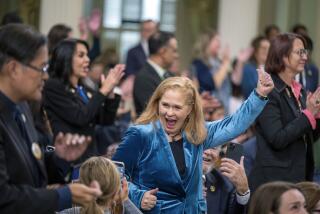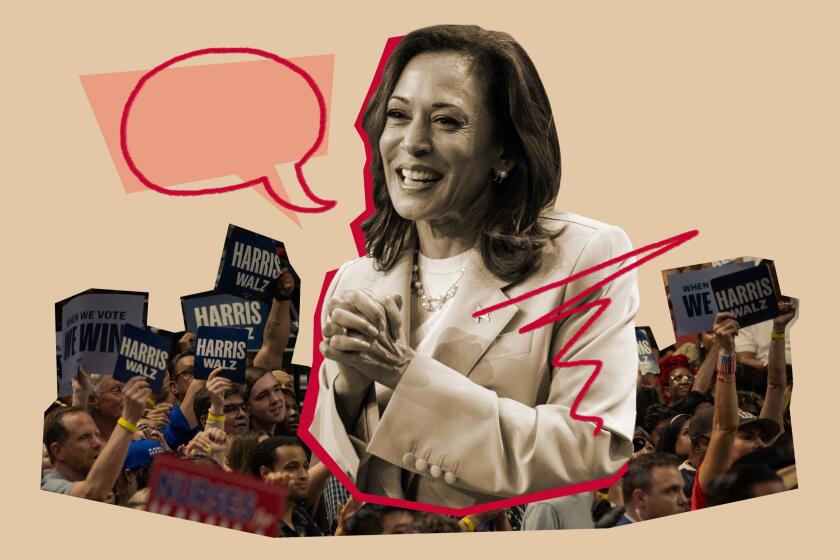California’s independent streak
From Sacramento — Democrats and Republicans will make all the noise, but nonpartisan independents will decide the winners of California’s competitive statewide elections in November.
That has increasingly become the case in recent years.
California may be a Democratic state, but it’s not true blue. And the best barometer of how it will vote in any general election is the fast-growing faction of independents.
They’re officially registered as “Decline to State” -- as in “a pox on both your parties.”
At last count, they make up 20% of registered voters, and the number keeps rising. In 1990 it was less than half that, 9%; in 2002 it was 15%.
Democrats represent about 45% of registered voters, down from 50% in 1990 but roughly the same as in 2002. Republicans have suffered a steady slide from 39% in 1990 to 31% last year.
Independent voters came under the national spotlight two weeks ago when they abandoned Democrats in Massachusetts and were largely responsible for electing Republican Scott Brown to the U.S. Senate seat held for nearly half a century by the late Edward M. Kennedy.
Washington-based Times columnist Doyle McManus later wrote that independents have been deserting President Obama all across the country. “They’re unhappy about the economy, worried about the potential costs of the Democrats’ healthcare bills and disappointed that Obama’s promises of bipartisanship didn’t come through,” McManus reported.
It’s a little different in California, based on recent surveys by two nonpartisan polling organizations: the Field Poll and the Public Policy Institute of California.
Field found a slight plurality of independents disapproving of Obama’s handling of healthcare while approving of his efforts on the economy. But overall, 61% of independents like the president’s job performance. And in the last year, they haven’t deserted Obama any more than Democrats have.
The Public Policy Institute found basically the same thing, and that a majority of independents remains confident the president and Congress will work together in a bipartisan way to achieve great deeds.
California’s independents are a more diverse conglomeration than the national model. They include many left-tilting minority voters. Mark DiCamillo, director of the Field Poll, says voters registered as Decline to State break out this way: whites 62%, Latinos 21%, Asians 13%, blacks 3%.
Among all Decline to State voters, DiCamillo says, only 30% identify with either major party, and those people lean Democrat by more than 2 to 1.
Additionally, Mark Baldassare, president and pollster for the policy institute, has found that this group is slightly weighted toward voters who are young, male, college-educated and -- most important -- centrist. In fact, 42% describe themselves as “middle of the road.” Only 30% of all likely voters call themselves that.
“They tend to be moderate and pragmatic,” Baldassare says. “Nobody can consider them reliable supporters. They tell us in polls that they lean Democrat, but we know from past experience they can support Republicans if they feel Democrats are too liberal.”
A good example: Gov. Arnold Schwarzenegger. Independents voted to recall Democratic Gov. Gray Davis in 2003 and to reelect Schwarzenegger over Democrat Phil Angelides in 2006.
Says DiCamillo: “When I’m doing a survey on a contested election, one of the first subgroups I look at is nonpartisans. I assume that Republicans and Democrats will go home to their parties.”
A close look at the two pollsters’ recent surveys shows the influence of independents. It’s striking how they represent the majority response on virtually every question. Not only are they on the winning side, but their numbers come close to matching the overall findings.
For example: In Baldassare’s poll, 58% of independents disapprove of Schwarzenegger; virtually the same as the 59% of all likely voters.
In a hypothetical November race for governor between Democratic Atty. Gen. Jerry Brown and Republican Meg Whitman, Brown leads by only five points among all voters, 41% to 36%. Independents give him an eight-point margin, 36% to 28%. Democrats and Republicans are at the predictable extremes.
Similarly in a U.S. Senate matchup between Democratic U.S. Sen. Barbara Boxer and Republican Tom Campbell: Boxer leads 45% to 41% among all voters; 42% to 37% with independents.
Neither major party can elect a candidate without the support of these swing voters, certainly not Republicans.
“They are the absolute determining factor in every competitive race, from governor to the Assembly,” says Allan Hoffenblum, a former Republican consultant who publishes the California Target Book, which handicaps legislative contests.
“The problem for Republicans is that independents are 40% people of color and they aren’t voting Republican. They look at the Republican Party as the white man’s party.
“And they look at the Democratic Party and can’t identify with the limousine liberals, the type you see quite often on the Westside of L.A. But when push comes to shove, they’ve been picking the Democrats because of the shrillness of the immigration debate.”
I asked Jaime Regalado, director of the Edmund G. “Pat” Brown Institute of Public Affairs, why young Latinos tend to register Decline to State. “It’s no different than a lot of other young people,” he says.
“There’s a certain independence in younger Latinos, who are ignoring the two-party system that perhaps hasn’t worked so well for their parents and grandparents. . . . But they tend to lean left of center, depending on the issue. They still see government as a good thing in their lives.”
The major parties allow independents to vote in their state primaries, but relatively few do. “It goes against their political instincts,” Baldassare says. “They kind of make the choice that ‘I’m not going to play that game.’ ”
They lie in wait until November.
More to Read
Get the L.A. Times Politics newsletter
Deeply reported insights into legislation, politics and policy from Sacramento, Washington and beyond. In your inbox three times per week.
You may occasionally receive promotional content from the Los Angeles Times.











